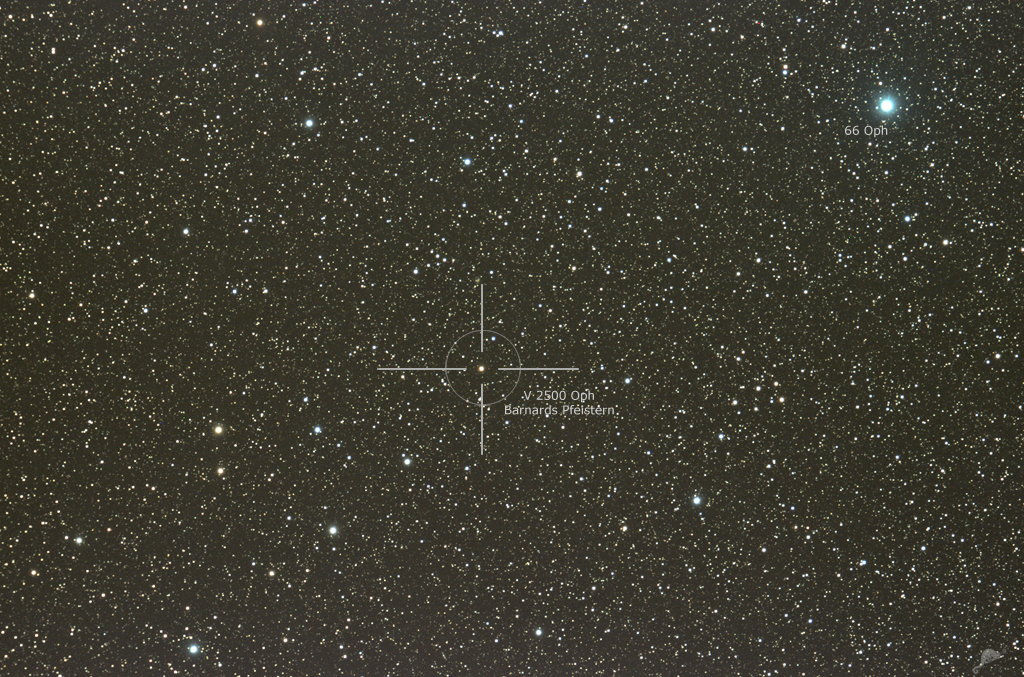 |
CHAMÄLEON + ONJALA OBSERVATORY DeepSky | SITEMAP HOME CHAMÄLEON |
|
 |
|||
| « back to overview Cluster | Load
higher resolution (1800 x 1200 Pixel 2800 x 2100
Pixel) |
Object description |

V 2500 Oph - Barnards Star
Barnards Star is a faint star in the constellation of the Serpens. With a distance of 5.94 (+/- 0.022) light-years Barnard's Star is the fourth closest to the solar system among the known stars. Only alpha, beta and Proxima Centauri are closer. Barnard's Star is a slightly variable red dwarf star of spectral type M5 and a visual magnitude of 9.6mag. It has only the 0.00044 luminosity of our Sun and is close to the star 66 Ophiuchus. By the year 11,800 it will approach the Sun up to 3.8 light-years and will then be the nearest fixed star to the Sun for some time.
The star has the highest known proper motion to date of RA = 0.8" and DE = 10.3" and moves at 140 kilometers per hour relative to our solar system. The large proper motion was discovered in 1916 by astronomer Edward Emerson Barnard.
Barnard's star caused a sensation in the 1960s when astronomer Peter van de Kamp announced the first discovery of a Jupiter-sized extrasolar planet orbiting the star. Observations of it were based on high-precision parallax measurements over many years, but it could never be confirmed.
All the more surprising in the fall of 2018, then, came the ESO announcement of the discovery of a planet orbiting Barnard's Arrow Star. The planet, referred to as Barnard's Star B, is now the second closest known exoplanet - besides Proxima Centauri B - to Earth. The data collected suggest the planet could be a super-Earth, with a mass at least 3.2 times that of Earth, which orbits Barnard's Arrow Star in about 233 days. For more details, see the ESO press release.
 |
The proper motion of Barnard's star between
2005 and 2019 In addition to Proxima Centauri C, we have also taken image series of Barnard's star irregularly since the year 2002 to document its fast proper motion. « The animation on the left shows the proper motion of Barnard's Arrow star between the years 2005 (with image marks) and 2019. Image data: (image orientation south top and west right). 2005: SBIG ST2000-XM and 6" Zeiss APQ refractor at f = 1,200 mm. 07.08.2005 - 20:00 UT, exposure 600 seconds. Observing site: Rooisand Observatory. 2019: ASI 071 Pro and 130mm Astro Physics refractor at f = 850 mm. 2019/09/30 - 20:30 UT, exposure 10 x 180 sec. Observing site: Onjala Observatory. |
| The proper motion of Barnard's star between
2002 and 2005 » The animation on theright shows the proper motion of Proxima Centauri towards the distant background stars between the years 2002 and 2005 in two images Image data (image orientation south top and west right) 2002: SBIG ST10-XME (pixel size 6.8 x 6.8 mü) and 5" Vixen ED refractor at f = 860 mm. 12.08.2002 - 21:30 UT, exposure 180 seconds. Observing site: Tivoli Guest Lodge- The raw image in 2002 was taken in very poor seeing and poor sky transparency. 2005: SBIG ST2000-XM (pixel size 7.4 x 7.4 mü) and 6" Zeiss APQ refractor at f = 1,200 mm. 07.08.2005 - 20:00 UT, exposure 600 seconds. Observation site: Rooisand Observatory. Click here or the thumbnail to load a large image animation. |
 |
 |
 |
 |
 |
 |
 |
 |
| Sun | Moon | Solar System | DeepSky | Widefield | Miscellaneous | Spec. Projects |